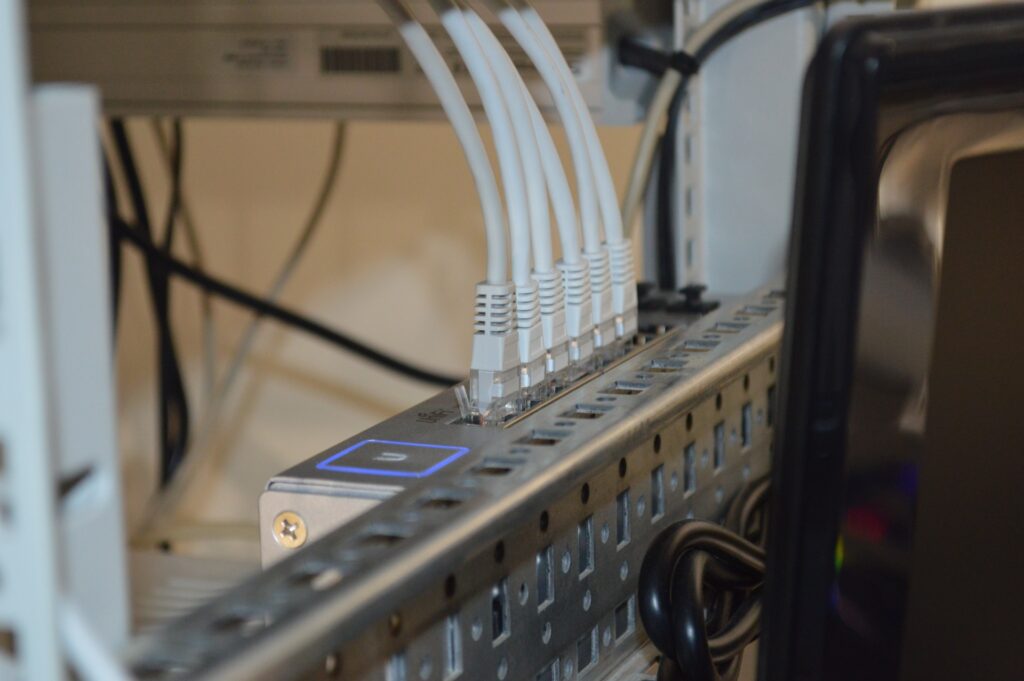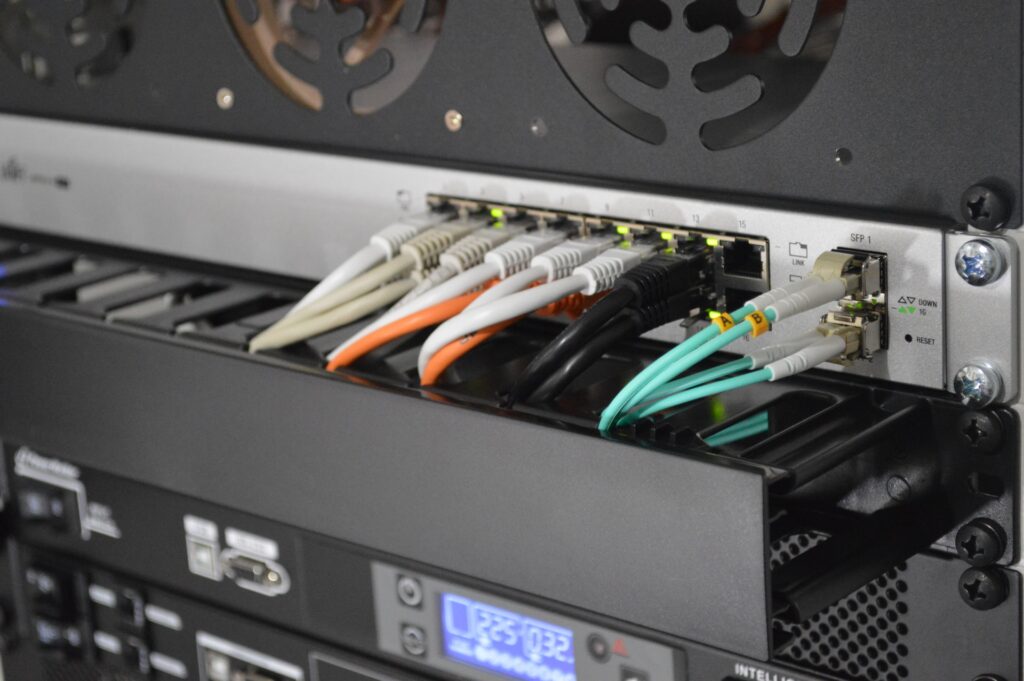In Dubai, UAE, Patch Cord Cable are like the essential wires that link devices together. They help data move between devices smoothly. These cables are essential for ensuring that information may flow easily between different locations, whether they are in large data centers or ordinary offices. This helps businesses and organizations in Dubai and the UAE work better and stay connected in this tech-savvy city.
I. Patch Cord Cable Types
- Ethernet Patch Cord: Used for network connections, Ethernet patch cords come in various categories, such as Cat5e, Cat6, and Cat7, offering different data transfer speeds.
- Fiber Optic Patch Cable: Ideal for high-speed data transmission, fiber optic patch cables transmit data as light signals, providing fast and secure connections.
- Coaxial Patch Cable: Coaxial patch cables carry high-frequency signals with less interference and are frequently used for cable TV and internet connections.
- HDMI Patch Cable: These cables are made for projectors, TVs, and other multimedia devices so that high-definition audio and video may be sent.
- USB Patch Cable: In order to ensure effective data transfer, USB patch cables can be used to connect a variety of devices, including printers, external hard drives, and smartphones,
- Audio Patch Cable (RCA): Used in audio setups, RCA patch cables transmit analog audio signals between devices like amplifiers and speakers.
- Power Patch Cable: These cables supply power to devices like laptops and chargers, ensuring a stable power connection.
- DisplayPort Patch Cable: Commonly used for computer monitors and display connections, DisplayPort cables offer high-quality video and audio transmission.
- Serial Patch Cable (RS-232): Serial patch cables connect legacy devices like industrial machinery and older computers through serial ports.

- Telephone Patch Cord: Traditional telephone patch cords connect landline phones to wall jacks, allowing for voice communication.
- Patch Panel Cable: Used to connect multiple devices to a patch panel, these cables help organize and manage network connections in data centers and offices.
- MIDI Patch Cable: Musicians and audio professionals use MIDI patch cables to connect musical instruments and equipment, enabling communication and control.
- Modular Patch Cable (RJ45): These cables are essential for creating custom Ethernet cables and connecting devices to network jacks.
II. Patch Cord Cable Ethernet Cable
The names “patch cord,” “cable,” and “Ethernet cable” all refer to the same kind of network cable, which is used to connect devices to a local area network (LAN).
- A patch cord cable, also known as an Ethernet cable, is constructed as a twisted-pair cable, featuring two pairs of insulated copper wires.
- Utilized for linking devices to a LAN network, like computers, routers, and switches, it serves as an Ethernet cable or patch cord cable.
- Available in various categories, each boasting its unique maximum speed and bandwidth capabilities, this Ethernet cable, or patch cord cable, offers versatility in networking options.
- The most common category of patch cord cable ethernet cable is Cat6, which can support speeds up to 10 Gbps.
- Patch cord cable ethernet cable is typically used in short lengths, up to about 100 meters.
- It is reasonably priced and simple to install.
III. Patch Cord Cable CAT6
- Gather your supplies: You will need a Cat6 patch cord crimper, a Cat6 cable, and two RJ45 connectors. You may also want to use a cable stripper and a wire stripper to make the process easier.
- Cut the cable to the desired length: Make certain to allocate sufficient extra cable at both ends, ensuring there’s ample room for wire stripping and the subsequent attachment of RJ45 connectors.
- Strip the outer jacket of the cable: Be careful not to cut the inner conductors.
- Untwist the inner conductors: Each conductor is twisted with a pair partner. Straighten the conductors.
- Cut the conductors to length: Leave about 1/2 inch of wire exposed
- Arrange the conductors in the correct order: Use the 568B wiring scheme for a standard patch cable.
- Insert the conductors into the RJ45 connector: Make sure that each conductor is inserted into the correct slot.
- Crimp the RJ45 connector: Use the Cat6 patch cord crimper to crimp the connector onto the cable.
- Test the patch cord: Connect the patch cord to two devices and test the connection.

IV. Patch Cords Cables Fiber
- Types of fiber patch cords: Two primary types of fiber patch cords exist single mode and multimode. Singlemode fiber patch cords are used for long-distance applications, while multimode fiber patch cords are used for short-distance applications.
- Fiber patch cord connectors: Numerous fiber patch cord connectors are available, including LC, SC, ST, and MTP, with the specific connector type required hinging on the devices you intend to interconnect.
- Fiber patch cord length: Fiber patch cords come in a variety of lengths. The required length, in turn, relies upon the separation between the devices you aim to link together.
- Fiber patch cord jacket: Fiber patch cords have a jacket that protects the fiber optic cable. The jacket can be made of PVC, LSZH, or other materials.
A. Can Ethernet Cables Go Outside?
For establishing LAN connections between residences or other structures, it’s possible to deploy Cat 6, Cat 5, or Cat 5e Ethernet cables outdoors. Although regular Ethernet cables can be utilized, the more expensive, weatherproof Cat 6 cables are the preferred choice.
B. What is The Use of Patch Cord Cable?
A patch cord cable serves the purpose of linking two electronic or optical devices together, facilitating the routing of signals between them. Devices including PCs, routers, and switches are usually connected to them in computer networks. Patch cord cables can be utilized in a variety of other systems, including audio and video ones.
C. What is The Difference Between Ethernet and Patch Cable?
Ethernet patch cables, characterized by their shorter and more pliable nature compared to standard Ethernet cables, find frequent application in connecting devices situated nearby, like linking a computer and a router or attaching a device to a patch panel. Patch cables usually have RJ-45 connectors on both ends.
Ethernet cables can be of any length and may have different types of connectors on each end. enabling their deployment for linking devices to a network, such as connecting a computer to a router, establishing connections between routers and switches, or even facilitating internet connectivity.